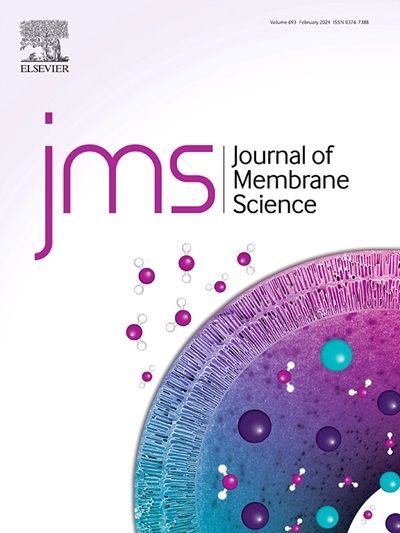Disentangling the gap between pure and mixed-gas performance of thin film composite membranes through improved cell design and testing methods
IF 8.4
1区 工程技术
Q1 ENGINEERING, CHEMICAL
引用次数: 0
Abstract
Testing thin film composite (TFC) membrane coupons at low stage-cuts (≤5 %) in a sweep-gas permeation system is a common practice to obtain mixed-gas separation properties for benchmarking performance and making scale-up decisions. However, even under these idealized conditions, mixed-gas permeance and selectivity can be more than 30 % lower than their pure-gas values, partially due to concentration polarization, an effect that typically intensifies with increased membrane permeance. This study investigates the effect of cell design on mixed-gas testing using PolyActive™ TFC membranes with pure-gas CO2 permeance of 1700–3100 gas permeance unit (GPU), covering the permeance range of most state-of-the-art CO2/N2 separation membranes. We designed and 3D-printed a counter-current permeation cell with enhanced feed and sweep flow efficiency, resulting in a 33–41 % increase in mixed-gas CO2 permeance compared to traditional permeation cells. Furthermore, we compared sweep-gas and vacuum permeation methods using traditional permeation cells, revealing that the latter delivers 41 % higher mixed-gas CO2 permeance, because vacuuming effectively minimizes the downstream concentration polarization. These findings highlight the importance of cell design and permeation apparatus selection in lab-scale mixed-gas testing, with strong implications for module design and process optimization at the industrial scale.

求助全文
约1分钟内获得全文
求助全文
来源期刊

Journal of Membrane Science
工程技术-高分子科学
CiteScore
17.10
自引率
17.90%
发文量
1031
审稿时长
2.5 months
期刊介绍:
The Journal of Membrane Science is a publication that focuses on membrane systems and is aimed at academic and industrial chemists, chemical engineers, materials scientists, and membranologists. It publishes original research and reviews on various aspects of membrane transport, membrane formation/structure, fouling, module/process design, and processes/applications. The journal primarily focuses on the structure, function, and performance of non-biological membranes but also includes papers that relate to biological membranes. The Journal of Membrane Science publishes Full Text Papers, State-of-the-Art Reviews, Letters to the Editor, and Perspectives.
 求助内容:
求助内容: 应助结果提醒方式:
应助结果提醒方式:


